Using free tools to customize the "Unchangeable" components of Windows 8
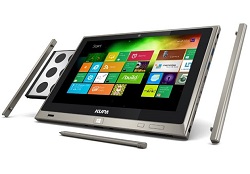 Many, if not to say - most of you have, as I am sure, managed to install and evaluate new features in the latest client operating system from Microsoft - Windows 8. In principle, some liked the new “Metro” interface, and someone immediately rushed look for opportunities to return "home" button " home " . Someone is actively using new packaged applications, and someone changes the registry values to immediately display the desktop instead of the initial screen. Someone had time to evaluate the capabilities of a graphical password, and someone did not like the changes associated with the ribbon interface in most standard applications, including the explorer. In other words, you can either put up with all the innovations, get used to new opportunities and work, as if nothing had happened, or constantly modify this or that functionality (as far as Microsoft can allow, of course) exclusively for your needs.
Many, if not to say - most of you have, as I am sure, managed to install and evaluate new features in the latest client operating system from Microsoft - Windows 8. In principle, some liked the new “Metro” interface, and someone immediately rushed look for opportunities to return "home" button " home " . Someone is actively using new packaged applications, and someone changes the registry values to immediately display the desktop instead of the initial screen. Someone had time to evaluate the capabilities of a graphical password, and someone did not like the changes associated with the ribbon interface in most standard applications, including the explorer. In other words, you can either put up with all the innovations, get used to new opportunities and work, as if nothing had happened, or constantly modify this or that functionality (as far as Microsoft can allow, of course) exclusively for your needs.However, in this operating system there are several such interesting features that simply do not change the interface and do not add / remove new features of the system, but simply are not subject to customization. So it is about such opportunities and will be discussed later in this article. In other words, in this article I will not talk about group policies, about Active Directory, and about Windows Server in particular. It will be exclusively about customization of the client operating system, and about customization of such system components, which can be changed only when using third-party utilities. Well then ...
Change menu items Power User Tasks Menu
 No matter how strange it is, but most people using the Windows 8 operating system are not aware of the existence of such an interesting menu called the Power User Tasks Menu. So what is it and why is it needed?
No matter how strange it is, but most people using the Windows 8 operating system are not aware of the existence of such an interesting menu called the Power User Tasks Menu. So what is it and why is it needed?In most cases, users of operating systems practically do not have such situations when they have a desktop with all the required shortcuts. And in general, to be honest, I have seen no more than five Windows users all the time, who would have such utilities on their desktop as, say, a registry editor, Process Monitor, a task scheduler, and other applications necessary for setting up and maintaining the system. . Even if they appear there, in order to get to such applications, users will need to minimize all open applications, and then launch their own shortcut. Naturally, all you need to do is execute the Win + D key combination, wait until everything is minimized and, roughly speaking, everything. But still it takes some time.
You can open the Run dialog and from there specify the application or utility that should be launched. This is also a time, and you also need to type something with your hands. In the end, you can pin the desired application on the taskbar, but it is, of course, not rubber, and, having fixed 6-7 programs on it, people are already beginning to think about whether or not to attach another application, and then search for the required element on panels.
Especially in order to significantly reduce the time to access the necessary applications designed primarily for system maintenance, the Power User Tasks Menu was created or, more simply, the Win + X menu. From its "abbreviated" name, it becomes obvious what combination of keys is required to open it. An alternative way to open this menu is to right-click on the bottom left of the screen. This menu opens very quickly, by default, you can open the power management window, the event viewer, the command line, the task manager and many other useful utilities from it. But there is one “but” ... This menu is simply impossible to edit with standard tools, which, without any doubt, is very unpleasant. But it would be convenient if there were the possibility of adding additional items to this menu (monitors with screen extensions, good, now the majority allow "eating" some space).
My friend, Sergey Tkachenko , relatively recently wrote a very convenient and simple utility designed to manage these menus. This utility is called “ Win + X Menu Editor for Windows 8 ”, which you can download at the link indicated in the utility name. First of all, I would like to note that the utility is absolutely free and practically does not take up disk space. So what is this utility?
The interface of this utility is so simple that even users who are very far from being called experienced can handle it. Immediately after opening this utility in the window that appears, you will see the contents of your Win + X menu, which includes the groups and the required utilities. Using the current utility, you can add as well-known administrative elements (for example, Windows PowerShell, Windows Firewall with Advanced Security, Task Scheduler, etc.), control panel items, which include the Windows components dialog box, personalization window, font settings, etc. , and also, if the required application or utility was not in the lists provided, you can select the last option using the “Add a program” option and the standard system dialog box for opening an application from its "native" location. You can see the window of the current utility with the drop-down list “ Add a program ” in the following illustration:

Fig. 1. Win + X Menu Editor Utility for Windows 8
For example, I thus added a utility from Mark Russinovich Process Monitor, a registry editor and a task scheduler to my third group on my client machine, and also created a new group for applications such as the Snipping Tool, Snagit editor, Windows Live Writer, whose help I publish posts on my blog, text editor Notepad ++, One Note and Outlook. Now, roughly speaking, all the applications that I run most often and which have not been allocated their place on the taskbar, I always have at hand.
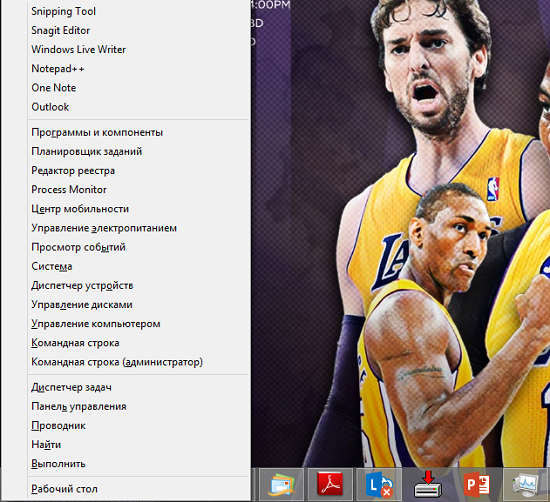
Fig. 2. Menu Win + X after all the changes
Adding commands to context menus
Context menus for many can be called a starting point for performing non-standard file operations. That is, if you want an additional command to appear in the context menu of a specific file type, you need to resort to editing the system registry or writing large reg files (in which errors can easily be made), with which, naturally, most users simply unable to handle.
Especially for solving such a problem, one kind Samaritan wrote a free utility called the Default Programs Editor . Using the functionality of such a utility, you can edit the context menu for any file, up to the option “Open with” .
Since this article is positioned as a small one, I’ll go straight to the example of using this utility. Suppose that we need to add the option “Play to K-Lite” in the context menu of MKV files. How is this done:
- In the utility window that appears, select the topmost option, the Context Menu option, as shown below:
')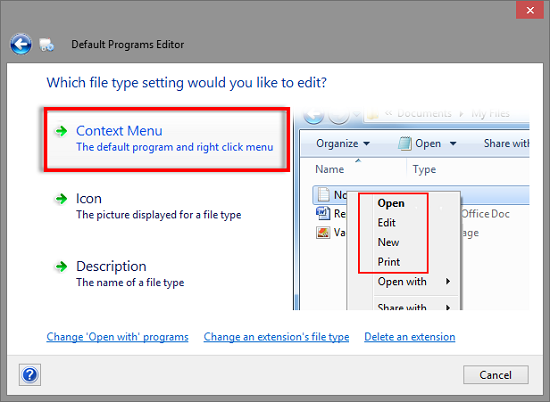
Fig. 3. Start page of this utility - After that, on the “ Select an extension to change ” page, select the required extension from the list provided. In our case, this extension is .mkv . For more convenience, you can use a heuristic search, as shown in the following illustration:
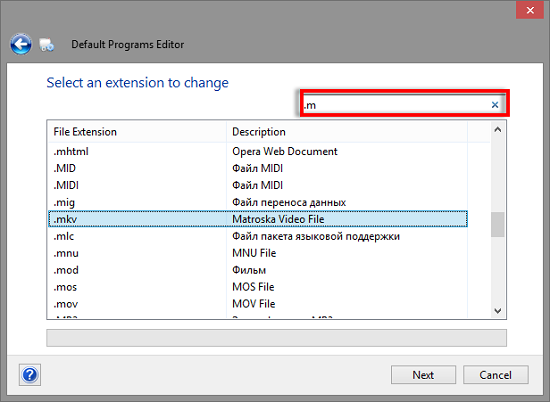
Fig. 4. Search for the required file type. - And now on the page “ Select and change context menu items for .mkv files ” you can add your menu items for the file type you selected on the previous page of the utility. Here you can either edit existing menu items or add a new, unique item. Let's try to add something new. To do this, simply click on the “Add” button, and then on the displayed page, enter the name of the new menu item and, of course, the path for the executable file. If desired, you can even add an icon for such an item. In this case, in the “ Command name ” text box, the text “ Play in K-Lite ” is specified, in the “Program Path” field - “" C: \ Program Files (x86) \ K-Lite Codec Pack \ Media Player Classic \ mpc- hc.exe ""% 1 "" (the path along with the parameter is indicated when selecting the appropriate file), and you can set the icon as the icon that will be offered by clicking on the browse button next to the " Item icon " option. In addition, you can also define some additional parameters. An example of such an added element can be found below:
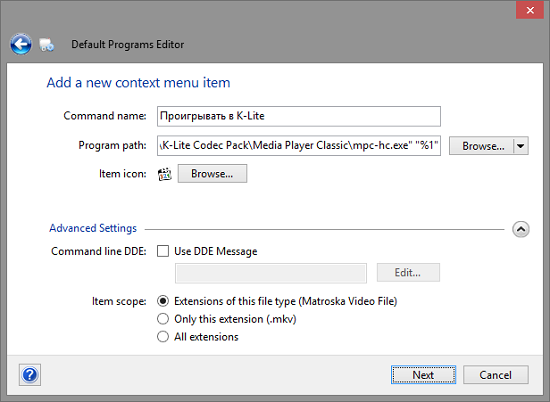
Fig. 5. Adding a new menu item - By the way, by clicking on the “Edit selected command” button, as I noted earlier, you can edit both the menu item you added and the one that was created by the operating system itself or by the embedded application. As you can see, all the changes you have made can be saved either directly into the registry or separately into a reg-file to create one unique file with all settings or for centralized deployment of such parameters. This utility save drop-down utility page appears in the following illustration:
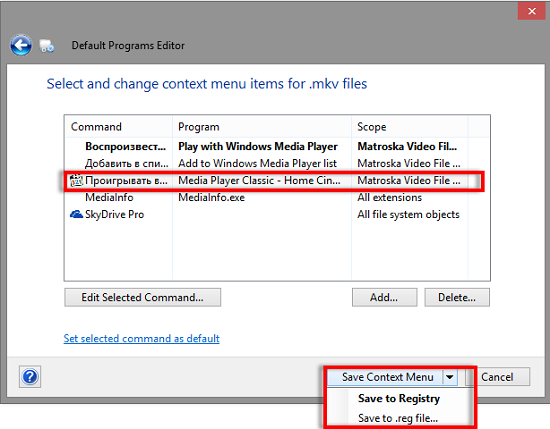
Fig. 6. Saving the changes made
Ultimately, you should have the following reg-file, which you can already use as you see fit:
[HKEY_CURRENT_USER\Software\Classes\KLCP.WMP.mkv\shell\KLite]
@=" K-Lite"
[HKEY_CURRENT_USER\Software\Classes\KLCP.WMP.mkv\shell\KLite\command]
@="\"C:\\Program Files (x86)\\K-Lite Codec Pack\\Media Player Classic\\mpc-hc.exe\" \"%1\""
[HKEY_CURRENT_USER\Software\Classes\KLCP.WMP.mkv\shell\KLite]
"Icon"="C:\\Program Files (x86)\\K-Lite Codec Pack\\Media Player Classic\\mpc-hc.exe,0"
Of course, after making all the changes, you don’t even have to restart the explorer.exe process. Everything will work just after re-opening Windows Explorer. The very result of such actions can be seen below:

Fig. 7. Result of changes made in the system
By the way, if you wish, you can even edit the icons and descriptions of any file types, as well as predetermine the default programs for the same types.
Results
In principle, these two free utilities are just a small example of how to change the components of the system, which, as it would seem, are not subject to change by means of the user interface. This article did not specifically consider any tweakers and registry cleaners, since, frankly speaking, they can sometimes only be more harm to the operating system than good, as it would seem to the average user. If this topic was interesting for you, in the next post I can consider methods for automating the cleaning of the operating system and the Windows 8 system registry from various debris using standard operating system tools.
Do you change the capabilities of any components in your system and add your options to them?
Source: https://habr.com/ru/post/178359/
All Articles